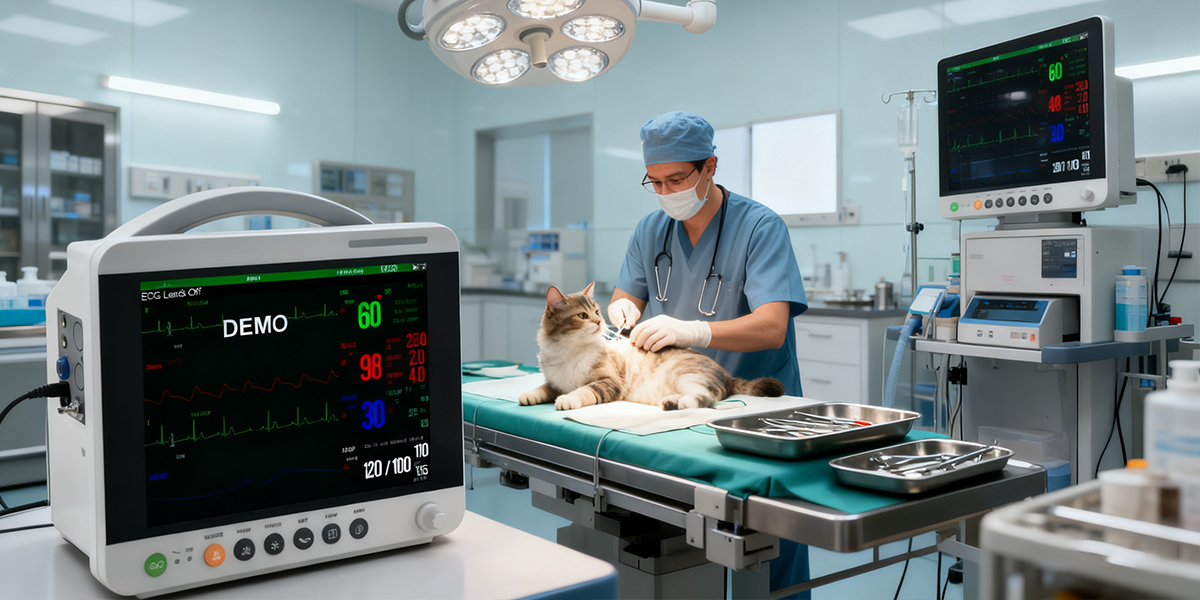How To Choose The Right Veterinary Multiparameter Monitor For Your Clinic
In modern veterinary practice, the standard of care has evolved dramatically. Gone are the days when simply monitoring a patient’s heartbeat and breathing was considered sufficient during procedures. Today, a single piece of equipment—the veterinary multiparameter monitor—stands at the center of patient safety, clinical efficiency, and a practice’s professional reputation.
However, selecting the right monitor can be a daunting task. A device that lacks essential functions not only limits the medical services your clinic can offer but also introduces significant risks during anesthesia and other critical procedures. This professional buyer’s guide will walk you through the essential steps of choosing a veterinary multiparameter monitor that not only meets your current clinical needs but also supports your clinic’s future growth.
Step 1: Assess Your Clinic’s Real-World Needs
Before looking at any specific model, the first step is to analyze your clinic’s primary use cases. Not every practice requires the same level of monitoring.
- Scenario A: Routine Check-ups & Post-Op Recovery For general wellness exams and post-operative recovery areas, your primary need is for basic vital signs monitoring. A portable, easy-to-use device with a long battery life is key. The essential parameters here are the basics: ECG, SpO2, and NIBP.
- Scenario B: Dental Suites & General Surgery This is where the requirements become more stringent. In addition to the basic parameters, monitoring a patient’s ventilation status under anesthesia is critical. Therefore, a monitor equipped with EtCO2 (End-tidal CO2) becomes a necessity, not a luxury. A clear screen, reliable data, and an intelligent alarm system are paramount.
- Scenario C: Specialty Hospitals & Referral Centers For advanced procedures and critical care, you need a full-featured system. This includes all standard parameters plus advanced options like IBP (Invasive Blood Pressure) and anesthetic gas monitoring. Data connectivity and modular upgrade potential are also key considerations for these high-level institutions.
Step 2: A Deep Dive into Core Parameters—What’s a “Must-Have”?
Understanding the clinical significance of each parameter helps you justify your investment.
- The Basics (ECG, SpO2, NIBP): These three form the foundation of patient monitoring, providing essential information on cardiac activity, blood oxygenation, and blood pressure. Any professional monitor must provide reliable readings for these core vitals.
- The Gold Standard for Anesthesia Safety: Why EtCO2 is Non-Negotiable This is the critical differentiator for any surgical monitor. EtCO2 is the “gold standard” for confirming proper intubation and continuously monitoring a patient’s ventilation. It provides an immediate, breath-by-breath assessment of respiratory status, alerting you to potential problems long before they would be visible on an SpO2 reading. For any clinic performing procedures under anesthesia, a monitor without EtCO2 is a monitor that’s missing the most important safety feature.
- Advanced Options (IBP, Anesthetic Gases): While not necessary for every clinic, the availability of these parameters on a monitor demonstrates the manufacturer’s technical depth and ability to cater to high-end specialty needs.

Step 3: Hardware & Usability—A Design That Truly Enhances Your Workflow
A monitor is only as good as its user interface and hardware. A poorly designed device can add stress and inefficiency to a busy clinical environment.
- Screen Clarity & UI: In a tense surgical situation, data must be instantly readable. Choose a monitor equipped with a brand-new, high-resolution TFT screen. This makes it significantly easier for clinicians to view critical data at a glance, reducing the risk of misinterpretation. As a bonus, look for models that offer an optional full-touchscreen interface. An intuitive, touch-based operating system dramatically reduces the learning curve and allows new team members to become proficient quickly.
- Data Management & Review: A superior monitor does more than just display real-time data; it should also feature dynamic waveform capture and recording. This functionality is invaluable for case reviews, academic purposes, and maintaining comprehensive medical records, showcasing the professionalism of your practice.
- Battery & Portability: A reliable, rechargeable battery with a long working time is essential. This ensures that monitoring is never interrupted, whether you’re moving a patient between rooms or facing an unexpected power outage.
- Durability & Cleaning: The monitor’s casing should be robust and, crucially, easy to clean and disinfect to maintain a sterile environment.
Step 4: Choose a Partner, Not Just a “Box”
When you purchase a medical device, you are not just buying a piece of hardware; you are entering into a long-term relationship with the manufacturer.
- Technical Support: When an issue arises, who can you call? Does the manufacturer offer prompt and knowledgeable remote or on-site support?
- Warranty: What is the warranty period, and what does it cover? A comprehensive warranty is a sign of a manufacturer’s confidence in their product’s quality.
- Training & Resources: Does the manufacturer provide operational training or online learning resources to help your team get the most out of the device?
The Olivevet Solution: The Smart Choice That Meets All Your Needs
Our veterinary multiparameter monitor was designed with a deep understanding of the needs of modern veterinary clinics. It not only features a large, high-resolution TFT screen and an optional full-touchscreen for intuitive operation but also includes powerful dynamic waveform recording and a long-life rechargeable battery. It perfectly satisfies all the critical requirements for clarity, ease of use, data management, and reliability that we’ve discussed.
Conclusion: A Long-Term Investment in Safety and Efficiency
Choosing the right veterinary multiparameter monitor is a wise investment in the future of your practice. It’s a commitment to a higher standard of medical safety, a tool to improve your team’s workflow efficiency, and a clear signal to your clients that you are dedicated to providing the best possible care for their beloved pets.
